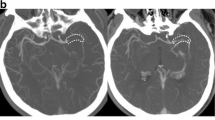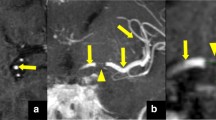Abstract
Purpose
To compare the association of different measures of intracranial thrombus permeability on non-contrast computerized tomography (NCCT) and computed tomography angiography (CTA) with recanalization with or without intravenous alteplase.
Methods
Patients with anterior circulation occlusion from the INTERRSeCT study were included. Thrombus permeability was measured on non-contrast CT and CTA using the following methods: [1] automated method, mean attenuation increase on co-registered thin (< 2.5 mm) CTA/NCCT; [2] semi-automated method, maximum attenuation increase on non-registered CTA/NCCT (ΔHUmax); [3] manual method, maximum attenuation on CTA (HUmax); and [4] visual method, residual flow grade. Primary outcome was recanalization with intravenous alteplase on the revised AOL scale (2b/3). Regression models were compared using C-statistic, Akaike (AIC), and Bayesian information criterion (BIC).
Results
Four hundred eighty patients were included in this analysis. Statistical models using methods 2, 3, and 4 were similar in their ability to discriminate recanalizers from non-recanalizers (C-statistic 0.667, 0.683, and 0.634, respectively); method 3 had the least information loss (AIC = 483.8; BIC = 492.2). A HUmax ≥ 89 measured with method 3 provided optimal sensitivity and specificity in discriminating recanalizers from non-recanalizers [recanalization 55.4% (95%CI 46.2–64.6) when HUmax > 89 vs. 16.8% (95%CI 13.0–20.6) when HUmax ≤ 89]. In sensitivity analyses restricted to patients with co-registered CTA/NCCT (n = 88), methods 1–4 predicted recanalization similarly (C-statistic 0.641, 0.688, 0.640, 0.648, respectively) with Method 2 having the least information loss (AIC 104.8, BIC 109.8).
Conclusion
Simple methods that measure thrombus permeability are as reliable as complex image processing methods in discriminating recanalizers from non-recanalizers.

Similar content being viewed by others
References
Menon BK, Al-Ajlan FS, Najm M et al (2018) Association of clinical, imaging, and thrombus characteristics with recanalization of visible intracranial occlusion in patients with acute ischemic stroke. JAMA 320:1017–1026
Chen Z, Shi F, Gong X, Zhang R, Zhong W, Zhang R, Zhou Y, Lou M (2018) Thrombus permeability on dynamic CTA predicts good outcome after reperfusion therapy. AJNR Am J Neuroradiol 39:1854–1859
Santos EM, Dankbaar JW, Treurniet KM et al (2016) Permeable thrombi are associated with higher intravenous recombinant tissue-type plasminogen activator treatment success in patients with acute ischemic stroke. Stroke 47:2058–2065
Santos EM, Marquering HA, den Blanken MD et al (2016) Thrombus permeability is associated with improved functional outcome and recanalization in patients with ischemic stroke. Stroke 47:732–741
Ahn SH, d'Esterre CD, Qazi EM, Najm M, Rubiera M, Fainardi E, Hill MD, Goyal M, Demchuk AM, Lee TY, Menon BK (2015) Occult anterograde flow is an under-recognized but crucial predictor of early recanalization with intravenous tissue-type plasminogen activator. Stroke 46:968–975
Mishra SM, Dykeman J, Sajobi TT et al (2014) Early reperfusion rates with IV tPA are determined by CTA clot characteristics. AJNR Am J Neuroradiol 35:2265–2272
Menon BK, Goyal M (2016) Clots, collaterals, and the intracranial arterial tree. Stroke. 47:1972–1973
Funding
This study was supported by an operating grant from the Canadian Institutes of Health Research and by a grant from the Swiss National Foundation (P300PB_161071).
Author information
Authors and Affiliations
Consortia
Corresponding author
Ethics declarations
Conflict of interest
Henrik Gensicke has received research support from the Swiss National Science Foundation. James W Evans, Fahad S. Al Ajlan, Dar Dowlatshah, Mohamed Najm, Ana L. Calleja, Josep Puid, Sung-lI Sohn, Seong H. Ahn, Alexandre Y Poppe, Negar Asdaghi, Albert Jin, Talip Asil, and Jean-Martin Boulanger declare that they have no conflict of interest. Robert Mikulik has been supported by the project no. LQ1605 from the National Program of Sustainability II (MEYS CR). Thalia S. Field has received research support from the Canadian Institutes of Health Research, the Michael Smith Foundation for Health Research, the Heart and Stroke Foundation of Canada, the Vancouver Coastal Health Research Institute, and Bayer Canada (study medication). Michael D. Hill is supported by the Heart & Stroke Foundation of Alberta-Hotchkiss Brain Institute Professorship in Stroke Research. Mayank Goyal has received consulting fees from Medtronic, Stryker, and Microvention and holds a patent on a system of acute stroke diagnosis licensed to GE Healthcare. Andrew M. Demchuk has received honoraria from Medtronic for CME events. He also received operational grant funding from the Canadian Institute for Health Research for the INTERRSeCT study. Bijoy K. Menon holds the Heart and Stroke Foundation Professorship in Stroke Imaging and has received operational grant funding from the Canadian Institute of Health Research.
Ethical approval
The study was approved by local ethics board of participating sites.
Informed consent
Informed consent was obtained from all individual participants included in the study.
Additional information
Publisher’s note
Springer Nature remains neutral with regard to jurisdictional claims in published maps and institutional affiliations.
Electronic supplementary material
Rights and permissions
About this article
Cite this article
Gensicke, H., Evans, J.W., Al Ajlan, F.S. et al. Comparison of different methods of thrombus permeability measurement and impact on recanalization in the INTERRSeCT multinational multicenter prospective cohort study. Neuroradiology 62, 301–306 (2020). https://doi.org/10.1007/s00234-019-02320-y
Received:
Accepted:
Published:
Issue Date:
DOI: https://doi.org/10.1007/s00234-019-02320-y




